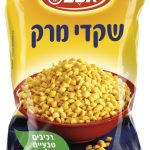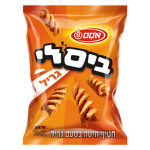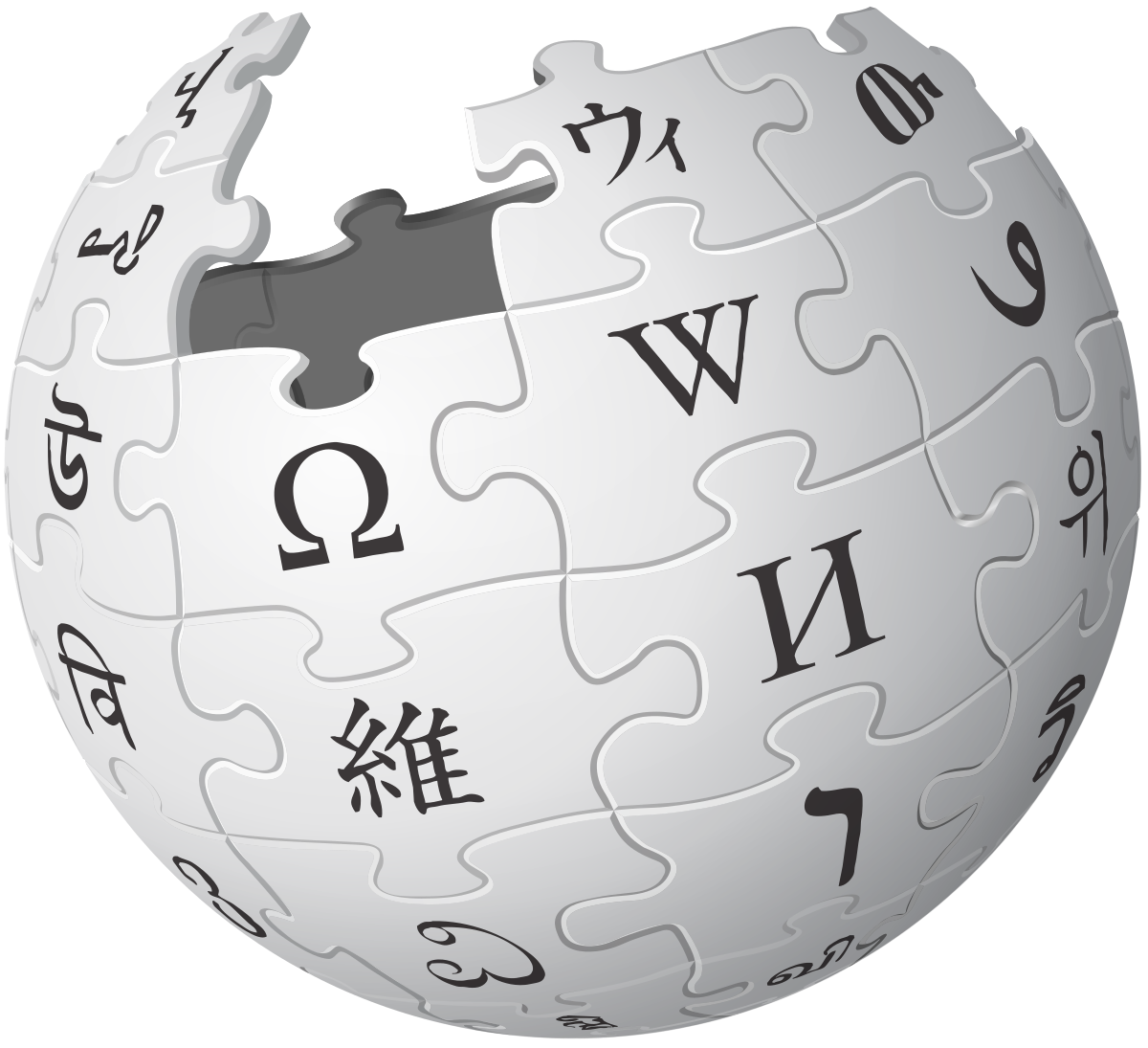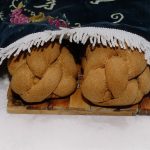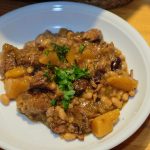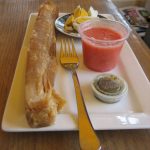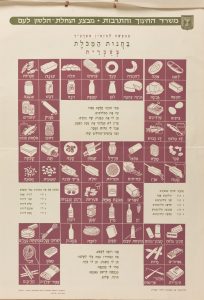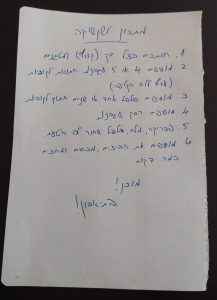?מטבח ישראלי, יש דבר כזה
“Is there an Israeli cuisine”? is a question that is not easy to answer, as we will see on this class. It is true that the Israeli food is taken from many different cuisines from all around the world, but does it necessarily mean that there is no such thing? This is what we will try to figure out today!
תוצרת הארץ – Made in Israel
Let’s start with foods you can find only in Israel! Can you read their names? What do you think we use it for? What is it made of? Try to take out as much information as possible from what’s written on them. These products are pure Israeli, and can be found mainly in Israel (almost exclusively):
Bamba originally was chease flavored (probably imitation of cheatos), but it didn’t succeed, so it was later changed to peanut butter flavour, and the rest is history. It became a big success! The name of the product was made so it will be easy for little kids to pronounce it. Maybe this is why it became such a success!
The Ptitim were invented at the time of the austerity in Israel. The prime minister back then, David Ben-Gurion, asked to make a cheap replacement for rice, and the Ptitim became the answer. They are made of baked pasta, and are eaten as a side dish.
Shkedei Marak (soup almonds), are called like this after their original shape (that looked like almonds). The shape has changed since then, but the name is still the same. This kind of food was tradicionally made at home, but remained a big success since the 50’s when it was first made indusrially, till nowadays.
This pasta shaped snack looks like fusilli, because it was first made by an israeli pasta company. It wascreated in the 70’s, after realizing that there’s a lack of sour snacks in the market. You can find this popular snack in different flavours: Grill, BBQ, Onion and even Falafel!
But What about other Israeli food? Well, some foods are not purely Israeli, but are called Israeli, and common in every restaurant in Israel. The first one is “Israeli breakfast”. If you go to a restaurant in Israel you will always see on the menu “breakfasts”, and usually they are served all through the day. The Israeli breakfast is almost always the same! Eggs (however you like them – scrambled, omelette or sunny side up), with salad (green or finely cut). Also in the deal – bread rolls and buns, different kind of spreads and something to drink (sometimes cold juice along side to hot coffee, or one of the two). If you prefer something lighter, you will usually also find a “Shakshouka” (dish made of cooked tomatoes, peppers, onion and eggs).
The second Israeli food (by name) is the Israeli salad (AKA Arab salad as well (we will also talk later about this point of the Arab-Israeli food conflict). Same salad you will get with your breakfast – finely cut vegetables (tomatoes, cucumbers and maybe onion, sometimes even parsley).
אוכל יהודי – Jewish Cuisine
The Jewish food has evolved over the centuries, when Jews were spreaded all over the world. Although the Jewish food vary from country to country, some elements are similar, because of the Jewish dietary law (kosher), the festivals and the shabbath – all are common to the whole Jewish world. Two main Jewish foods are the Challah and the Chamin. These two existed all over the jewish world (even if in a bit different versions), while other jewish dishes are specific to certain geographic areas.
Challah – חלה
The Challah is mentioned in the Bible, and it is not clear the origin of the word (the root of the word can mean sweet, holed or even circled). Be that as it may, the word Challah appears twice in the bible:
“רֵאשִׁית, עֲרִסֹתֵכֶם–חַלָּה, תָּרִימוּ תְרוּמָה: כִּתְרוּמַת גֹּרֶן, כֵּן תָּרִימוּ אֹתָהּ”. (במדבר ט”ו, כ)
“As the first yield of your baking (challah), you shall set aside a loaf as a gift; you shall set it aside as a gift like the gift from the threshing floor”. (Numbers, 15, 20)
“וַיְחַלֵּק לְכָל-הָעָם לְכָל-הֲמוֹן יִשְׂרָאֵל לְמֵאִישׁ וְעַד-אִשָּׁה לְאִישׁ חַלַּת לֶחֶם אַחַת וְאֶשְׁפָּר אֶחָד וַאֲשִׁישָׁה אֶחָת וַיֵּלֶךְ כָּל-הָעָם אִישׁ לְבֵיתוֹ”. (שמואל ב, ו, י”ט)
“And he distributed among all the people—the entire multitude of Israel, man and woman alike—to each a loaf of bread (challah), a cake made in a pan, and a raisin cake. Then all the people left for their homes”. (Samuel II, 6, 19)
The Challah is eaten traditionally on Sabbath eve and in holidays (except Passover, when bread is forbidden). Today the Challah is sold mainly on Fridays, and it is the Ashkenazi version of it. Interestingly, other kinds of bread, similar to Challah, are found in several countries in Europe and South Africa.
Chamin – חמין
Other typical dishes in Israel:
All food images are taken from Wikipedia
סכסוך האוכל הערבי־ישראלי – The Israli-Arab Food Conflict
As you might already know, Falafel is considered to be the national food of Israel. This is of course something many Arabs don’t like that Israel is saying. In fact, most of what we call Israeli food, has Arab roots (mainly because Jews from Arab countries brought this food with them). As for the Falafel, its origin is not clear, and it is arguable, but it clearly existed in the Arab cuisine. So why is Falafel considered as the national food, and is it really? All started in the 50’s, with the song “Falafel” (see next section), that talked about how every nation has a national dish, and ours is “Falafel”. But is it?
A short YouTube video clip made by Kan (an Israeli State-owned free-to-air television channel founded in 2017) start with these lines:
למה אתם כותבים שפלאפל זה אוכל ישראלי? זה אוכל ערבי! וואלה יופי, אחרי שגנבו לנו את האדמה עכשיו הציונים גונבים לנו גם את האוכל?
The video explain the origin of the Falafel (at least the theories about it). The conclusion is:
כמו שאף אחד לא מפקפק בעובדה שההמבורגר אמריקאי, למרות שכביכול הגיע מגרמניה, ושהפסטה איטלקית, למרות שבמקור, כך על פי שמועות, הגיעה מסין. ויש עוד עניין. אנחנו ממש שדרגנו אותו. ברוב המזרח התיכון אוכלים אותו בצלחת, כמנת צד. אנחנו דחסנו אותו לתוך פיתה, הוספנו תוספות מערביות כמו כרוב כבוש, צ’יפס, מלפפון חמוץ וגם עמבה מעיראק. וזה? כל זה כבר לגמרי שלנו.
You can watch the full video here, with Hebrew or English subtitles here!
So is Falafel Israeli? Is Cappucchino Italian, even though the coffee is from Latin America? You will be the judges! And what a better way to finish this class with the nostalgic song – Falafel
שיר – Song
לכל מדינה כאן בעולם,
מאכל לאומי המוכר לכולם,
וכל ילד בגן יודע כי
האוכל מקרוני הוא איטלקי.
לאוסטרים בווינה שניצל טעים,
והצרפתים אוכלים צפרדעים.
הסינים אוכלים אורז דק ורזה,
והקניבלים אוכלים זה את זה.
ולנו יש פלאפל, פלאפל, פלאפל.
לאבא מתנה, גם אמא כאן קונה.
לסבתא הזקנה נקנה חצי מנה.
וגם החותנת היום תקבל,
פלאפל, פלאפל,
עם הרבה, הרבה, הרבה,
עם הרבה, הרבה, הרבה,
פלפל!
For every country in the world,
there’s a national dish everyone knows,
and every kid in kindergarten knows
that the one who eats Macaroni is Italian.
The Austrians in Vienna have a tasty schnitzel,
and the french eat frogs.
The chinese eat a thin long rice,
and the cannibals eat one another.
And we have Falafel, Falafel, Falafel,
A gift for dad, Mom buys here too,
To the old grandma we will buy half the size.
And the mother-in-law will also get today,
Falafel, Falafel,
With a lot, a lot, a lot,
With a lot, a lot, a lot,
of (hot) pepper!
פיסה קטנה של היסטוריה – Small Piece of History
The Hebrew language was not used as a native tongue of anyone for long centuries. When the first “Aliyah” came to Israel, and especially after the establishment of Israel as a country, Hebrew was revived. This poster of the government showed the people how to ask for whatever they needed from the minimarket in Hebrew.
From the phrases in the poster we can see it’s from the 50’s, when Israel had its austerity times. Most of the words are still used today the same way they did, but some have changed. For example, we no longer say הדקים, but אטבים (clothespin), and instead of כעך, which some people do use today, we mostly say בייגלה (pretzel).
Still Hungry? Let’s see if you can make a Shakshuka out of my mom’s recipe!
(*Tip: to make it even better – add a bit of sugar to the recipe!)
בהצלחה!
Shakshuka Recipe:
1. Cut an onion thin and fry.
2. Add 4, 5 diced tomatoes (it’s better if they’re pilled).
3. Add one to two diced (red) peppers.
4. Add concentrated tomato paste.
5. Paprika, salt, black pepper to taste.
6. Add the eggs, cover the pan and wait a few minutes.
READY! ENJOY YOUR MEAL!


